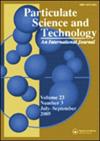离心径向床中心管锥形通道结构优化的理论分析与数值模拟研究
IF 1.5
4区 工程技术
Q3 ENGINEERING, CHEMICAL
引用次数: 0
摘要
摘要为了改善径向床内流动分布的均匀性,提出了不同的锥形通道设计方法,即比例法、传统的最小化通道两端压力差的线性设计方法、新提出的最小化整个通道压力轴向变化的改进线性设计方法以及将通道划分为不同倾角的多段改进多段线性设计方法。通过数值模拟研究了不同设计方法和不同气体流速下的流场。锥形通道角度的指定尤为重要。与原始结构相比,比例法难以获得合适的倾角,其压降ηp和气速ηv分布的不均匀性指数可能增大或减小。传统线性法的不均匀性指数较低,ηv降低≥7.02%,表明流动分布更均匀;改进线性法和多级线性法的不均匀性指数最低,ηv分别降低≥12.12%和13.60%。此外,后两种方法对气体流量波动具有良好的适应性和鲁棒性。提出了两种新的锥形通道设计方法。引入非均匀性指标来量化流动分布的均匀性。对不同设计方法的鲁棒性进行了评价。关键词:离心径向床;数值模拟;结构优化;张勤川:数据管理。王若金:写作审查,监督。王德武:资源。孟唐:写作评论。张少峰:写作-评论。披露声明作者声明,他们没有已知的竞争经济利益或个人关系,可能会影响本文所报道的工作。作者声明没有可能被视为潜在竞争利益的经济利益/个人关系。作者感谢河北省自然科学基金项目(B2021202022, B2022202003)的资助和支持。本文章由计算机程序翻译,如有差异,请以英文原文为准。
Theoretical analysis and numerical simulation study on the structural optimization of conical channels in the center tube of a centrifugal radial bed
AbstractTo improve the uniformities of the flow distributions in radial beds, different design methods for conical channels were developed, that is, proportional method, traditional linear method for minimizing the pressure difference between two ends of the channel, newly proposed improved linear method for minimizing the pressure axial variation in the whole channel, and improved multi-segment linear method that divide the channel into multi-segments with different inclination angles. The flow fields under different design methods and gas flow rates are then investigated by numerical simulation. The designation of the angle of the conical channel is particularly significant. Compared to the original structure, the proportional method has difficulty obtaining a proper inclination angle, whose inhomogeneity indices of the distributions of pressure drop ηp and gas velocity ηv may increase or decrease. The traditional linear method has lower inhomogeneity indices, for example, ηv will decrease by ≥7.02%, which denotes more uniform flow distributions, while the improved linear and multi-stage linear methods have the lowest inhomogeneity indices, for example, ηv will decrease by ≥12.12 and 13.60%, respectively. Besides, the latter two methods have good adaptability and robustness to fluctuations in the gas flow rate.HIGHLIGHTSTwo new design methods of conical channel are proposed.Inhomogeneity indices are introduced to quantify the uniformity of flow distribution.Robustness of different design methods are evaluated.Keywords: Centrifugal radial bednumerical simulationstructural optimizationconical channelinhomogeneity indices Authors’ ContributionHaonan Xu: Investigation, Writing-original draft. Qinchuan Zhang: Data curation. Ruojin Wang: Writing-review, Supervision. Dewu Wang: Resources. Meng Tang: Writing-review. Shaofeng Zhang: Writing- review.Disclosure StatementThe authors declare that they have no known competing financial interests or personal relationships that could have appeared to influence the work reported in this paper. The authors declare no financial interests/personal relationships which may be considered as potential competing interests.Additional informationFundingThe authors would like to thank the Programs of Natural Science Foundation of Hebei Province, China(B2021202022, B2022202003) for funding and support.
求助全文
通过发布文献求助,成功后即可免费获取论文全文。
去求助
来源期刊

Particulate Science and Technology
工程技术-工程:化工
CiteScore
4.40
自引率
4.00%
发文量
86
审稿时长
12 months
期刊介绍:
Particulate Science and Technology, an interdisciplinary journal, publishes papers on both fundamental and applied science and technology related to particles and particle systems in size scales from nanometers to millimeters. The journal''s primary focus is to report emerging technologies and advances in different fields of engineering, energy, biomaterials, and pharmaceutical science involving particles, and to bring institutional researchers closer to professionals in industries.
Particulate Science and Technology invites articles reporting original contributions and review papers, in particular critical reviews, that are relevant and timely to the emerging and growing fields of particle and powder technology.
 求助内容:
求助内容: 应助结果提醒方式:
应助结果提醒方式:


